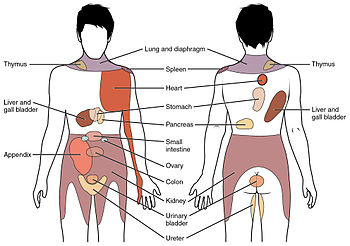
Back ألم رجيع Arabic Dolor referit Catalan Forskudt smerte Danish Dolor referido Spanish درد ارجاعی Persian 関連痛 Japanese 연관통 Korean Weerpijn Dutch Referert smerte NB Ból rzutowany Polish
This article needs additional citations for verification. (September 2020) |
| Referred pain | |
|---|---|
 Conscious perception of visceral sensations map to specific regions of the body, as shown in this chart. Some sensations are felt locally, whereas others are perceived as affecting areas that are quite distant from the involved organ. | |
| Identifiers | |
| MeSH | D053591 |
| Anatomical terminology | |
Referred pain, also called reflective pain,[1] is pain perceived at a location other than the site of the painful stimulus. An example is the case of angina pectoris brought on by a myocardial infarction (heart attack), where pain is often felt in the left side of neck, left shoulder, and back rather than in the thorax (chest), the site of the injury. The International Association for the Study of Pain has not officially defined the term; hence, several authors have defined it differently. Referred pain has been described since the late 1880s. Despite an increasing amount of literature on the subject, the biological mechanism of referred pain is unknown, although there are several hypotheses.
Radiating pain is slightly different from referred pain; for example, the pain related to a myocardial infarction could either be referred or radiating pain from the chest. Referred pain is when the pain is located away from or adjacent to the organ involved; for instance, when a person has pain only in their jaw or left arm, but not in the chest. Radiating pain would have an origin, where the patient can perceive pain, but the pain also spreads ("radiates") out from this origin point to cause the pain to be perceived in a wider area in addition.
- ^ Arendt-Nielsen L, Svensson P (2001). "Referred muscle pain: basic and clinical findings". Clin J Pain. 17 (1): 11–9. doi:10.1097/00002508-200103000-00003. PMID 11289083. S2CID 27091223.